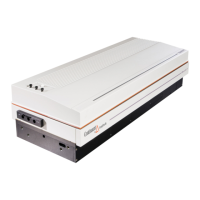Precision II Operation and Maintenance Manual
C
2-18
996-0255 rev. b
CU601C RS232
TxD 2|————————>|3RxD
RxD 3<—————————|2TxD
RTS 4|—| |—|5 CTS
CTS 5|—| |—|4 RTS
SIGNAL COMMON 7|———------———|7 SIGNAL COMMON
| |—|6 DSR
| |—|20 DTR
D25 MALE D25 FEMALE
CONNECTOR CONNECTOR
Pins 4 & 5 on the CU601C end are tied together. It is also recomended to
tie together pins 4 & 5 and pins 6 & 20 on the PC end.
A typical interface cable for RS232 interface and the CU601C is in the
example below:
CU601C RS232
TxD 2 |—————————>|2
RxD 3 |<—————————|3 TxD
RTS 4 |—| |—|8 CTS
CTS 5 |—| |—|7 RTS
SIGNAL COMMON 7 |———------———|5 SIGNAL COMMON
| |—|6 DSR
| |—|4 DTR
D25 MALE D9 FEMALE
CONNECTOR CONNECTOR
Pins 4 & 5 on the CU601C end are tied together. It is also recomended to
tie together pins 7 & 8 and pins 4 & 6 on the PC end.
d) Host computer demo program
Listed below is a demo control program to control the CU601C through
the RS232 channel. The program was written in Microsoft QUICK BASIC
and run on a PC or equivalent. Your PC must have a serial card installed,
an RGB display card (or equivalent) and a 360 K floppy disk. An RS232
cable, as described in part c, must be installed between the CU601C and
the computer.
100 ‘*****************************************************************************
105 ‘* CONTINUUM/SANTA CLARA, CA *
110 ‘* SOFTWARE RS232 COMMUNICATION DEMO FROM IBM-PC*
120 ‘* TO CU601 LASER COMPUTER. *
130 ‘* AUTHOR: RAY PARKER 1-21-88 *
135 ‘* LANGUAGE: MICROSOFT QUICK BASIC 4.5 *
136 ‘* REVISED: 6/29/90 R. PARKER *
140 ‘*****************************************************************************

